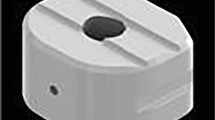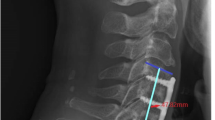Abstract
Background
Anterior cervical discectomy and fusion (ACDF) is widely performed for the treatment of cervical spinal degenerative disease. Autogenic or allogenic bone grafts are used for interbody fusion with satisfactory long term outcomes. However, harvest of the autograft causes donor site complications and allograft is associated with low fusion rate. Threaded titanium cages (TC) have recently been introduced to cope with these disadvantages, but there is little evidence of long term results.
Methods
The long term outcome was studied after ACDF using TC. Clinical and imaging follow up was performed in 41 patients for at least 5 years (range 5–8.3 years). New computer-assisted measurement methods for radiographs are proposed.
Findings
ACDF with TC achieved 80% excellent or good outcome by Odom’s criteria, 95% fusion rate, and few minor complications. Asymptomatic adjacent disc degeneration was detected in 50% of the patients by our measurement methods. However, symptomatic adjacent disc degeneration occurred in 5% of the patients and only 2% required additional surgery.
Conclusions
These results are comparable or better than those after ACDF with autograft or allograft. ACDF with TC can achieve rigid fixation and provide good long term results.






Similar content being viewed by others
References
Baba H, Furusawa N, Imura S, Kawahara N, Tsuchiya H, Tomita K (1993) Late radiographic findings after anterior cervical fusion for spondylotic myelo-radiculopathy. Spine 18:2167–2173
Bishop RC, Moore KA, Hadley MN (1996) Anterior cervical interbody fusion using autogenic and allogenic bone graft substrate: a prospective comparative analysis. J Neurosurg 85:206–210
Bohlman HH, Emery SE, Goodfellow DB, Jones PK (1993) Robinson anterior cervical discectomy and arthrodesis for cervical radiculopathy. Long-term follow-up of one hundred and twenty-two patients. J Bone Joint Surg Am 75:1298–1307
Chagas H, Domingues F, Aversa A, Vidal Fonseca AL, de Souza JM (2005) Cervical spondylotic myelopathy: 10 years of prospective outcome analysis of anterior decompression and fusion. Surg Neurol 64(Suppl 1):S1:30–S1:36
Clements DH, O’Leary PF (1990) Anterior cervical discectomy and fusion. Spine 15:1023–1025 doi:10.1097/00007632-199015100-00008
Dai LY, Jiang LS (2008) Anterior cervical fusion with interbody cage containing beta-tricalcium phosphate augmented with plate fixation: a prospective randomised study with 2-year follow-up. Eur Spine J 17:698–705 doi:10.1007/s00586-008-0643-8
Dmitriev AE, Cunningham BW, Hu N, Sell G, Vigna F, McAfee PC (2005) Adjacent level intradiscal pressure and segmental kinematics following a cervical total disc arthroplasty: an in vitro human cadaveric model. Spine 30:1165–1172 doi:10.1097/01.brs.0000162441.23824.95
Edwards CC 2nd, Riew KD, Anderson PA, Hilibrand AS, Vaccaro AF (2003) Cervical myelopathy. Current diagnostic and treatment strategies. Spine J 3:68–81 doi:10.1016/S1529-9430(02)00566-1
Gercek E, Arlet V, Delisle J, Marchesi D (2003) Subsidence of stand-alone cervical cages in anterior interbody fusion: warning. Eur Spine J 12:513–516 doi:10.1007/s00586-003-0539-6
Gore DR, Sepic SB (1984) Anterior cervical fusion for degenerated or protruded discs. A review of one hundred forty-six patients. Spine 9:667–671 doi:10.1097/00007632-198410000-00002
Hacker RJ (2000) A randomised prospective study of an anterior cervical interbody fusion device with a minimum of 2 years of follow-up results. J Neurosurg 93:222–226
Hauerberg J, Kosteljanetz M, Boge-Rasmussen T, Dons K, Gideon P, Springborg JB, Wagner A (2008) Anterior cervical discectomy with or without fusion with Ray titanium cage: a prospective randomised clinical study. Spine 33:458–464
Herkowitz HN, Kurz LT, Overholt DP (1990) Surgical management of cervical soft disc herniation. A comparison between the anterior and posterior approach. Spine 15:1026–1030 doi:10.1097/00007632-199015100-00009
Hilibrand AS, Carlson GD, Palumbo MA, Jones PK, Bohlman HH (1999) Radiculopathy and myelopathy at segments adjacent to the site of a previous anterior cervical arthrodesis. J Bone Joint Surg Am 81:519–528
Hilibrand AS, Robbins M (2004) Adjacent segment degeneration and adjacent segment disease: the consequences of spinal fusion. Spine J 4:190S–194S doi:10.1016/j.spinee.2004.07.007
Ishihara H, Kanamori M, Kawaguchi Y, Nakamura H, Kimura T (2004) Adjacent segment disease after anterior cervical interbody fusion. Spine J 4:624–628 doi:10.1016/j.spinee.2004.04.011
Kao FC, Niu CC, Chen LH, Lai PL, Chen WJ (2005) Maintenance of interbody space in one and two-level anterior cervical interbody fusion: comparison of the effectiveness of autograft, allograft, and cage. Clin Orthop Relat Res 430:108–116 doi:10.1097/01.blo.0000142626.90278.9e
Lunsford LD, Bissonette DJ, Jannetta PJ, Sheptak PE, Zorub DS (1980) Anterior surgery for cervical disc disease. Part 1: treatment of lateral cervical disc herniation in 253 cases. J Neurosurg 53:1–11
Malloy KM, Hilibrand AS (2002) Autograft versus allograft in degenerative cervical disease. Clin Orthop Relat Res 394:27–38 doi:10.1097/00003086-200201000-00004
Matge G, Leclercq TA (2000) Rationale for interbody fusion with threaded titanium cages at cervical and lumbar levels. Results on 357 cases. Acta Neurochir (Wien) 142:425–434 doi:10.1007/s007010050453
Mizuno J, Inoue T, Nonaka M, Ohara Y, Nakagawa H (2006) Surgical outcomes of anterior cervical decompression and interbody fixation using titanium interbody cages for cervical discogenic disease and OPLL. Spine Spinal Cord 19:1117–1122 Jpn
Moreland DB, Asch HL, Clabeaux DE, Castiglia GJ, Czajka GA, Lewis PJ, Egnatchik JG, Cappuccino A, Huynh L (2004) Anterior cervical discectomy and fusion with implantable titanium cage: initial impressions, patient outcomes and comparison to fusion with allograft. Spine J 4:184–191 doi:10.1016/j.spinee.2003.05.001
Profeta G, de Falco R, Ianniciello G, Profeta L, Cigliano A, Raja AI (2000) Preliminary experience with anterior cervical microdiscectomy and interbody titanium cage fusion (Novus CT-Ti) in patients with cervical disc disease. Surg Neurol 53:417–426 doi:10.1016/S0090-3019(00)00207-X
Rao RD, Wang M, McGrady LM, Perlewitz TJ, David KS (2005) Does anterior plating of the cervical spine predispose to adjacent segment changes? Spine 30:2788–2793 doi:10.1097/01.brs.0000190453.46472.08
Ray CD (1997) Threaded titanium cages for lumbar interbody fusions. Spine 22:667–680 doi:10.1097/00007632-199703150-00019
Schmieder K, Wolzik-Grossmann M, Pechlivanis I, Engelhardt M, Scholz M, Harders A (2006) Subsidence of the wing titanium cage after anterior cervical interbody fusion: 2-year follow-up study. J Neurosurg Spine 4:447–453 doi:10.3171/spi.2006.4.6.447
Senter HJ, Kortyna R, Kemp WR (1989) Anterior cervical discectomy with hydroxylapatite fusion. Neurosurgery 25:39–43 doi:10.1097/00006123-198907000-00007
Seo M, Choi D (2008) Adjacent segment disease after fusion for cervical spondylosis; myth or reality? Br J Neurosurg 22:195–199 doi:10.1080/02688690701790605
Shamsaldin M, Mouchaty H, Desogus N, Costagliola C, Di Lorenzo N (2006) Evaluation of donor site pain after anterior iliac crest harvesting for cervical fusion: a prospective study on 50 patients. Acta Neurochir (Wien) 148:1071–1074 doi:10.1007/s00701-006-0864-8
Smith GW, Robinson RA (1958) The treatment of certain cervical spine disorders by anterior removal of the intervertebral disc and interbody fusion. J Bone Joint Surg Am 40-A:607–624
Tureyen K (2003) Disc height loss after anterior cervical microdiscectomy with titanium intervertebral cage fusion. Acta Neurochir (Wien) 145:565–570
van Jonbergen HP, Spruit M, Anderson PG, Pavlov PW (2005) Anterior cervical interbody fusion with a titanium box cage: early radiological assessment of fusion and subsidence. Spine J 5:645–649 doi:10.1016/j.spinee.2005.07.007
Weinhoffer SL, Guyer RD, Herbert M, Griffith SL (1995) Intradiscal pressure measurements above an instrumented fusion. A cadaveric study. Spine 20:526–531 doi:10.1097/00007632-199503010-00004
Williams JL, Allen MB Jr, Harkess JW (1968) Late results of cervical discectomy and interbody fusion: some factors influencing the results. J Bone Joint Surg Am 50:277–286
Yue WM, Brodner W, Highland TR (2005) Long-term results after anterior cervical discectomy and fusion with allograft and plating: a 5 to 11 year radiologic and clinical follow-up study. Spine 30:2138–2144 doi:10.1097/01.brs.0000180479.63092.17
Zdeblick TA, Ducker TB (1991) The use of freeze-dried allograft bone for anterior cervical fusions. Spine 16:726–729 doi:10.1097/00007632-199107000-00006
Author information
Authors and Affiliations
Corresponding author
Additional information
Comments
In this manuscript the authors made a long term follow up study of fusion rate and adjacent disc degeneration after anterior discectomy using titanium cages in 41 patients. The manuscript is well written and this reviewer encourage reports of outcome studies after various neurosurgical procedures, making comparisons between centers and own data possible, a necessity for the advancement of surgical techniques. Especially, there are only a few long term outcome studies of the now widely used Titanium cages.
Anders Lewén
Uppsala University, Sweden
For patients with degenerative disc disease at one or two cervical levels, discectomy (removal of the disc) alone results in a shorter hospital stay with a similar rate of fusion of the adjoining vertebrae than surgical techniques that use autograft (using your own bone for a graft). Surgical techniques that use autograft provide a better chance for fusion than those using a cage for additional stability, although the evidence is weak 1,2.
This study was performed to assess the biomechanical properties of the anterior cervical cage fusion constructs, as compared to bone graft fusion constructs. It was interesting to note that the caudad fusion level at C6–7 gave a relatively high stress in the bone graft, which is indeed observed clinically. The cage constructs provided inferior stability as compared to the bone graft constructs, especially for the two-level construct. In the two level fusion constructs, the intermediate vertebra (C6) showed higher stresses than the vertebrae superior and inferior to the fusion (C5 and C7) under all moment loads. This stress levels were much higher in the cage construct, which implies susceptibility of the subsidence or bone collapse in the cage construct.
1. Jacobs WCH, Anderson PG, van Limbeek J, Willems PC, Pavlov P (2004) Single or double-level anterior interbody fusion techniques for cervical degenerative disc disease. Cochrane Database Syst Rev. 2004 Oct 18;(4):CD004958.
2 Ruberté LM, Natarajan RN, Andersson GB.(2009)
Influence of single-level lumbar degenerative disc disease on the behavior of the adjacent segments-A finite element model study.
J Biomech. 2009 Jan 9. [Epub ahead of print]
Kenneth Casey
Detroit, USA
Rights and permissions
About this article
Cite this article
Sugawara, T., Itoh, Y., Hirano, Y. et al. Long term outcome and adjacent disc degeneration after anterior cervical discectomy and fusion with titanium cylindrical cages. Acta Neurochir 151, 303–309 (2009). https://doi.org/10.1007/s00701-009-0217-5
Received:
Accepted:
Published:
Issue Date:
DOI: https://doi.org/10.1007/s00701-009-0217-5




